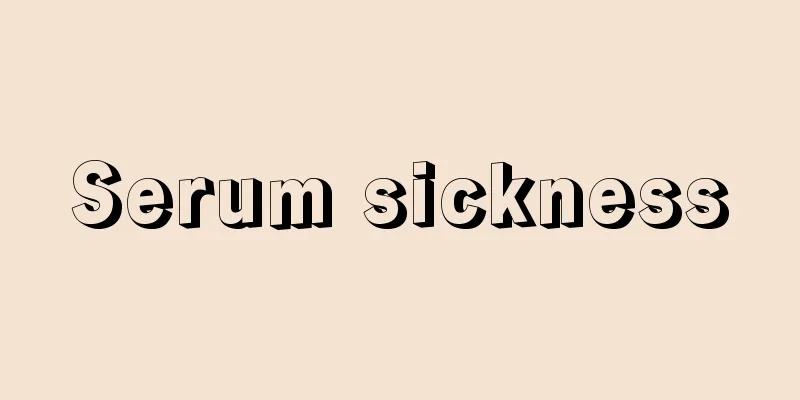Serum sickness

|
Concept Serum sickness is a disease concept proposed by von Pirquet and Schick as a condition that causes skin rash, fever, joint pain, and lymph node swelling due to the deposition of immune complexes (IC) formed 1-2 weeks after administration of heterologous serum. Similar conditions are known to be caused by bee venom, bacterial or viral infections, and drugs, and are referred to as serum sickness-like reactions. Etiology and epidemiology: Classical serum sickness has become relatively rare in Japan with the decline of antiserum therapy for tetanus, diphtheria, rabies, etc. On the other hand, there has been an increase in serum sickness caused by antithymocyte globulin preparations used to treat aplastic anemia, and by biological preparations, which have recently become more common in the treatment of immune disorders such as rheumatoid arthritis and inflammatory bowel disease, and blood disorders such as lymphoma. Serum sickness-like reactions have also increased with the increased use of penicillin and cephalosporin antibiotics. Serum sickness-like reactions have also been reported due to sulfa drugs, hydantoins, thiazides, anti-inflammatory drugs, etc. Pathophysiology Serum sickness is a type III allergic reaction in which antibodies are produced against antigens such as foreign proteins, and the resulting ICs are deposited in vascular walls and renal glomeruli, causing tissue damage. The tissue damage caused by ICs depends on the subclass of antibodies that compose the ICs. In general, IgG1, IgG2, IgG3, and IgM, which activate complement via the classical pathway, are more damaging to tissues than IgG4, IgA, and IgE. The tissue damage caused by ICs also depends on the size of the ICs, and it is said that medium-sized soluble ICs formed in areas of antigen excess are more likely to deposit in tissues. ICs deposited in tissues activate the complement system, which produces anaphylatoxins such as C3a and C5a, which activate mast cells, increase vascular permeability, and induce neutrophil migration. The expression of adhesion molecules and chemokines is also involved in the local infiltration of inflammatory cells. Furthermore, IC activates Fc receptors on neutrophils and macrophages, inducing the production of inflammatory cytokines, the release of lysosomal enzymes, and the production of superoxide, resulting in tissue damage. In drug-induced serum sickness-like reactions, it is speculated that the drug binds to serum proteins and acts as a hapten, inducing an immune response similar to that of foreign serum. Clinical symptoms: Fever, skin rash, arthralgia, fatigue, and lymphadenopathy appear 1 to 2 weeks after administration of the xenogeneic serum. Renal symptoms such as proteinuria, hematuria, and edema, gastrointestinal symptoms such as nausea, abdominal pain, and bloody stools, myalgia, peripheral neuritis, serositis, myocarditis, and uveitis may also occur. Skin symptoms are frequent (more than 90%) and generally appear before joint symptoms. Urticaria is the most common, but measles-like skin rash, erythema on the sides of the fingers and toes, erythema on the palms, and purpura with palpable induration may also appear. Unlike Stevens-Johnson syndrome, mucosal lesions and ulcers are rare. Joint symptoms are most common in large joints such as the wrists, ankles, and knees, and are characterized by severe pain. In most mild cases, symptoms disappear spontaneously within a few days, but in severe cases, they may persist for several weeks. If symptoms persist for more than a month, other diseases such as collagen disease should be suspected. Serum sickness-like reactions caused by drugs also improve rapidly when the causative drug is discontinued. In cases where the patient has already been sensitized, severe anaphylaxis-like symptoms such as generalized urticaria, difficulty breathing, and wheezing may appear soon after administration (1-4 days). Test Results: There are no test findings characteristic of serum sickness. White blood cell counts are often increased, but there are also cases where they are decreased. Atypical lymphocytes may appear. CRP turns positive, and the erythrocyte sedimentation rate is elevated. There is a decrease in complement levels (C3, C4) and an increase in IC. Mild proteinuria and hematuria may also be observed. In a biopsy of the rash, immunofluorescence reveals deposition of C3, IgG, IgM, and IgA in the blood vessel walls. Diagnosis and Differential Diagnosis Serum sickness should be suspected if fever, skin rash, joint pain, or lymphadenopathy are observed within 3 weeks after administration of a foreign serum or drug. Itching, swelling, and redness at the injection site provide clues to the diagnosis. If a diluted solution of the suspect drug or foreign serum is injected intradermally and redness and wheals appear, this is likely the cause. Differential diagnosis is necessary from infectious mononucleosis, rheumatic fever, malignant lymphoma, adult-onset Still's disease, reactive arthritis, drug-induced hypersensitivity syndrome, microscopic polyangiitis, collagen diseases such as systemic lupus erythematosus, and gonorrhea. Treatment and prognosis: Discontinue administration of the xenogeneic serum and medications. Once discontinued, the condition will improve naturally and the prognosis is generally good. Symptomatically, antihistamines are administered for urticaria and vasomotor edema, and nonsteroidal anti-inflammatory drugs are administered for fever and arthralgia. In severe cases, 20-40 mg of prednisolone is administered daily, and the dosage is carefully reduced and discontinued as symptoms improve. It can usually be discontinued after 2-3 weeks. When using prophylactic xenogeneic serum, the patient should be interviewed about past history of xenogeneic serum treatment and intradermal or eye drop tests should be used to confirm the absence of serum hypersensitivity. If intradermal or eye drop tests are positive, the use of the serum should be avoided as much as possible, but if its use is essential, rapid desensitization should be performed. [Nakajima Hirofumi] ■ References Wener, MH: Serum sickness and serum sickness-like reactions. In: UpToDate, Feldweg AM (ed), UpToDate, Waltham, 2010. Source : Internal Medicine, 10th Edition About Internal Medicine, 10th Edition Information |
|
概念 血清病は,異種血清投与1~2週後に形成された免疫複合体(immune complex:IC)の沈着により皮疹,発熱,関節痛,リンパ節腫脹などを生じる病態としてvon Pirquetと Schickにより提唱された疾患概念である.類似の病態は,ハチ毒,細菌やウイルス感染,薬剤が原因となり生じることが知られており,血清病様反応(serum sickness-like reaction)と表される. 病因・疫学 破傷風,ジフテリア,狂犬病などに対する抗血清療法の減少に伴い,わが国では古典的な血清病は比較的まれなものとなった.一方,再生不良性貧血の治療に用いられる抗胸腺細胞グロブリン製剤による血清病や,近年関節リウマチや炎症性腸疾患などの免疫疾患やリンパ腫などの血液疾患の治療に用いられることが多くなった生物学的製剤に起因する血清病が増加している. 血清病様反応もペニシリン系やセファロスポリン系抗生物質の使用量の増加に伴い増加している.その他,サルファ剤,ヒダントイン,サイアザイド,抗炎症薬などによる血清病様反応も報告されている. 病態生理 血清病は,異種蛋白などの抗原に対し抗体が産生され,その結果形成されたICが血管壁や腎糸球体などに沈着して組織傷害を引き起こすⅢ型のアレルギー反応である.ICの組織傷害性は,ICを構成する抗体のサブクラスに依存し,一般に古典的経路で補体を活性化するIgG1,IgG2,IgG3,IgMはIgG4,IgA,IgEより組織傷害性が高い.ICの組織傷害性は,ICの大きさにも依存し,抗原過剰域で形成される中等大の可溶性ICが組織に沈着しやすいとされる.組織に沈着したICは補体系を活性化し,C3a,C5aなどアナフィラトキシンの産生により,マスト細胞の活性化,血管透過性の亢進,好中球の遊走を惹起する.炎症細胞の局所浸潤には,接着分子やケモカインの発現も関与する.さらにICは好中球やマクロファージのFc受容体を活性化し,炎症性サイトカインの産生,ライソゾーム酵素の遊離,スーパーオキシドの産生を誘導し組織を傷害する.薬剤による血清病様反応では,薬剤が血清蛋白と結合しハプテンとして作用し,異種血清と類似の免疫応答を惹起すると推測される. 臨床症状 異種血清の投与1~2週後に発熱,皮疹,関節痛,倦怠感,リンパ節腫脹を生じる.蛋白尿,血尿,浮腫などの腎症状,悪心,腹痛,血便などの消化管症状,筋肉痛,末梢神経炎,漿膜炎,心筋炎,ブドウ膜炎なども起こりうる.皮膚症状は頻度が高く(90%以上),一般に関節症状に先行して出現する.じんま疹が最も多いが,麻疹様の皮疹,手指および足趾側面の紅斑,手掌紅斑,触知可能な硬結を伴う紫斑を呈することもある.Stevens-Johnson症候群とは異なり粘膜病変や潰瘍を呈することはまれである.関節症状は手首,足首,膝などの大関節に多く,疼痛が強いのが特徴である.軽症例の多くは,数日で症状が自然消失するが,重症例では数週間持続することもある.1カ月以上続く場合は膠原病など他疾患を疑う必要がある.薬剤による血清病様反応の場合も原因薬剤の中止とともに速やかに改善する.すでに感作されている症例では,投与後早期(1~4日)に全身のじんま疹,呼吸困難,喘鳴などアナフィラキシー様の重篤な症状が出現することがある. 検査成績 血清病に特徴的な検査所見はない.白血球数は増加する例が多いが減少例もある.異型リンパ球が出現することもある.CRPは陽性化し,赤沈は亢進する.補体価(C3,C4)の低下とICの増加を認める.軽度の蛋白尿や血尿を認めることもある.皮疹部の生検では免疫蛍光法で血管壁にC3,IgG,IgM,IgAの沈着を認める. 診断・鑑別診断 異種血清や薬剤の投与後3週間以内に発熱,皮疹,関節痛,リンパ節腫脹を認めたら血清病を疑う.注射部位の瘙痒,腫脹,発赤は診断の糸口となる.被疑薬や異種血清の希釈液を皮内に注射し,発赤と膨疹が出現すれば原因である可能性が高い.伝染性単核球症,リウマチ熱,悪性リンパ腫,成人発症Still病,反応性関節炎,薬剤性過敏症症候群,顕微鏡的多発血管炎,全身性エリテマトーデスなどの膠原病,淋菌感染症などとの鑑別が必要である. 治療・予後 異種血清や薬剤の投与を中止する.中止すれば自然に軽快し,予後は一般に良好である.対症的に,じんま疹,血管運動神経性浮腫には抗ヒスタミン薬,発熱,関節痛には非ステロイド系抗炎症薬を投与する.重症例にはプレドニゾロン20~40 mg/日を投与し,症状の改善にあわせて慎重に減量,中止する.通常2~3週で中止可能である. 予防 異種血清を使用する場合には,過去の異種血清治療歴を問診し,皮内試験法あるいは点眼試験法で血清過敏症が存在しないことを確認してから投与する.皮内試験や点眼試験が陽性の際はできる限り使用を避けるべきであるが,使用が必須の場合は急速減感作を行う.[中島裕史] ■文献 Wener, MH: Serum sickness and serum sickness-like reactions. In: UpToDate, Feldweg AM (ed), UpToDate, Waltham, 2010. 出典 内科学 第10版内科学 第10版について 情報 |
Recommend
Ratification
The act of a state's competent organ giving fi...
Kosode Soga - Kosode Soga
The title of a Noh piece. The fourth piece. A cont...
Oama [Hot Spring] - Oama
This hot spring is located in the former Oten vill...
Ashoka Temple
Located at the foot of Mount Ashoka, about 16km fr...
Responsive Passion - Oushou Fujunankyoku
…Leonhard Lechner's (c. 1553-1606) four-part ...
Youth class - Seinengakkyu
These are social education programs run by municip...
"Eros + Massacre" screening incident
…The right to privacy has developed in the United...
Hippias (English spelling)
[Born] Around 560 B.C. Died 490 BC. Lemnos? Ancien...
Cardinal vowels
A phonetic vowel is a set of phonemes and the phon...
Zenzaburo Kojima
Western-style painter. Born in Fukuoka City. In 1...
Eratosthenes - Eratosthenes
The first systematic geographer of the Hellenisti...
SSKD - SS K D
...The group expanded into the newly built Tokyo ...
Sakartvelos Sabchota Sotsialisturi Respublika (English spelling) Sakartvelos Sabchota Sotsialisturi Respublika
…Official name: Republic of GeorgiaSakartvelos Re...
Polypodium edodes - Polypodium edodes
A weedy perennial plant of the Juncaceae family (i...
Curtain - Maku
A type of cloth shielding device. While manmaku (...









